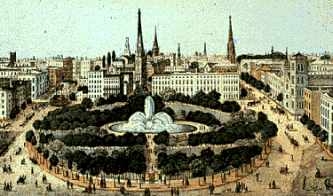
The Seneca Village Website.
| The Journal for MultiMediaHistory Volume 1 Number 1 ~ Fall 1998 |
 |
The Seneca Village Website. |
Now the exhibit remains accessible to all via a Web site located at http://projects.ilt.columbia.edu/seneca/start.html. The exhibit and the Web site (both heavily based on Elizabeth Blackmar and Roy Rosenzweig's recent The Park and The People: A History of Central Park) tell the story of Seneca Village, a community of about three hundred free African Americans and German and Irish immigrants who inhabited an area on Manhattan's west side (82nd to 89th Streets between Seventh and Eighth Avenue) which was destroyed in 1857 in order to build Central Park. The site was created by the New York Historical Society, the New York Public Library's Office of Young Adult Services, and the Institute for Learning Technologies at Columbia University.
The site is designed for junior high and high school students, promising the user "the opportunity to become a historical detective who will reconstruct the story of a nineteenth-century community based on clues recovered from the past." The site includes numerous primary sources�census records, maps, newspaper accounts, and images�and explanatory text that is both clear and informative. The "Introduction to Primary and Secondary Sources" is a useful and well-written section describing the types of primary sources to be found in the site and how historians use them to gain an understanding of the past. One section contains examples of work about Seneca Village created by New York City middle schoolers, and another provides an extensive list of books on African-American history which identifies those suitable for readers at the junior high-school level. "Reconstructing Seneca Village" provides a structured exercise, as the user assumes the identity of Andrew Williams (believed to be Seneca Village's founder) and uses the primary sources in the site to learn more about Williams and the Seneca Village community.
 |
Source: The Seneca Village Website. |
Using and supplementing the materials which made up the museum exhibit, The Seneca Village Website covers the history of African Americans in New York during the colonial and antebellum eras, including a page on the slave trade and the middle passage. It also covers the history of New York City generally during these eras (albeit not quite as thoroughly) and the planning and building of Central Park. This site, while breaking no new ground in terms of using the Web as a narrative medium distinct from exhibit format, does succeed admirably as a way to widen access to a valuable museum exhibit and as a resource for teachers.
Ellen Noonan
New York University Libraries
![]() Comments to: [email protected]
Comments to: [email protected]
Contents: JMMH, Volume 1 number 1 ~ Fall 1998